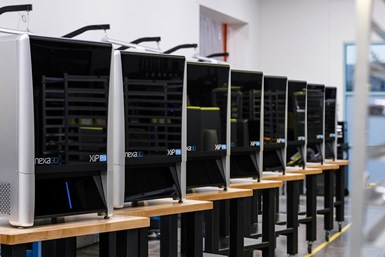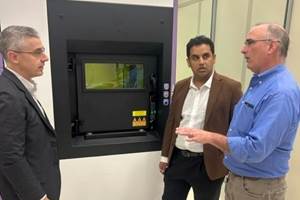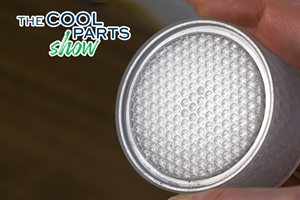Nexa3D XiP Pro Industrial 3D Printer Designed for Fast, Quality Production
The XiP Pro delivers highest daily throughput at the lowest operational costs for the production of industrial and medical device components, enabling onshoring and reshoring efforts with additive manufacturing.
Nexa3D says its XiP Pro is an ultrafast industrial 3D printer, providing the highest daily production throughput and lowest total cost of ownership in its class. Featuring print speeds faster than the traditional SLA and DLP-based technologies, more powerful print engine and a 19.5-L build volume, the XiP Pro delivers previously unattainable production capabilities for industrial users.
For companies looking to leverage additive manufacturing to de-risk and streamline supply chains, scaling production economically has been a challenge due to the inherent tradeoffs between print speed and production quality. Add to that the capital associated with establishing an additive factory and the ongoing operational costs, the return on investment may become elusive. With XiP Pro there is no need to compromise.
“We packaged our most advanced technologies into the XiP Pro, and let me tell you, it exceeds all expectations for what’s possible in terms of productivity and total cost of ownership,” says Avi Reichental, Nexa3D Co-founder, chairman and CEO. “XiP Pro is a paradigm shift for industrial users looking to scale additive production. The printer’s compact but rugged aluminum enclosure is built for a tough production floor setting and performance longevity.
“I am proud and humbled by my fellow Nexers and the innovation powerhouse we are building, anchored in over 180 patents, a comprehensive polymer product portfolio spanning a broad range of resin (LSPc) systems, and rapidly expanding powder bed fusion (QLS) solutions,” Reichental says.
The XiP Pro features the largest build volume in its class. With a 19.5-liter build volume, a single XiP Pro delivers the daily throughput of at least four competitive resin-based printers, enabling users to dramatically change the economics of 3D printing production, on top of reducing capital investment in equipment. With its unique stacking ability, users can optimize each build by stacking smaller parts on top of one another to take full advantage of XiP Pro’s entire z-stage.
It is said the printers offers ultrafast print speed without compromising quality. With an industry-leading print speed of up to 24 vertical cm/hr., XiP Pro can produce its entire build volume in under two hours without sacrificing print quality or surface finish. Its LCD-based print technology uses a self-lubricating membrane that reduces peel forces and enables fast print speeds. The LED light engine further enables high resolution and high-quality surface finish on 3D printed parts.
The XiP Pro also boasts a 7K resolution LCD screen with 46-micron pixel size ensuring that every detail of a design is captured with unparalleled precision, and resulting in finished products that are both stunning and accurate. The XiP Pro’s advanced sensor package, adaptive layer-by-layer printing technology and closed-loop z-stage with auto-homing capabilities deliver enhanced printability and improved first-time build success rate.
The XiP Pro comes with access to over 30 validated industrial resins on Nexa3D’s open material platform with more industrial and dental materials qualified and added monthly. The printer offers a broad range of high-performance materials ranging from strong and durable resins (such as xABS, xPP and xCE) to elastomeric materials (such as xFLEX475 and xFLEX402). It is a versatile industrial 3D printer, whether for prototyping in clear or modeling resins, or producing end-use components and 3D printed molds using heat-resistant resins, such as xPEEK, xCERAMIC or xMOLD.
“Nexa3D has done a great job bringing down the costs of 3D printing while increasing production capacity,” says Glen Mason, director, advanced manufacturing at Wilson Sporting Goods/DeMarini Sports, a member of select Nexa3D users with early access to the XiP Pro. “(Its) printers are getting bigger, faster and more affordable, which is a total win for users. I’m super excited about the XiP Pro as it is the tool I need to get to a larger scale, giving us about a 10X throughput compared to where we’re at today. With a larger build platform, we’re able to print larger parts, and stack smaller parts for maximum throughput. It’s positively taking the technology in every direction, decreasing cost per part while increasing resolution, speed and build capacity.”
XiP Pro comes with a new and enhanced NexaX OS — an intelligent, scalable platform for workflow automation, speed efficiency and productivity — featuring faster print prep engine and remote monitoring. The NexaX OS suite enables faster and more automated workflow, fleet management and remote monitoring. It also enables faster generation of support structures in multiple shapes, faster slicing, border compensation on base layers and print file size reduction, all of which further optimize and accelerate print prep and build time.
- Read about the Nexa3D XiP Desktop 3D printer for production-grade polymer 3D printing, which features ultrafast speeds, a large build volume and a validated, user-friendly workflow.
- Nexa3D is continuously expanding its materials portolio. Learn how Nexa3D added ceramic, flexible, clear materials by working with material experts at BASF and Henkel to validate custom formulations for its ultrafast fleet of industrial and desktop 3D printers.
- Learn about the Nexa3D QLS 820 high-throughput laser sintering platform. This high-throughput thermoplastic production system combines ultrafast printing with open materials and cloud-based software platform to deliver production volumes much greater than other powder-bed solutions on the market.
Related Content
New Zeda Additive Manufacturing Factory in Ohio Will Serve Medical, Military and Aerospace Production
Site providing laser powder bed fusion as well as machining and other postprocessing will open in late 2023, and will employ over 100. Chief technology officer Greg Morris sees economic and personnel advantages of serving different markets from a single AM facility.
Read MoreCranial Implant 3D Printed From Hydroxyapatite Ceramic: The Cool Parts Show #76
Cranial implants are typically made from titanium or PEEK; in this episode of The Cool Parts Show, we look at how implants made from a bioceramic can improve osseointegration and healing.
Read MoreUltra-Complex 3D Printed Scaffolds Enable Cell Growth: The Cool Parts Show #70
Perhaps the ultimate surface-area challenge is in bioengineering: creating structures that can grow sufficient cells within a compact volume to be effective for leading-edge medical treatments. The Southwest Research Institute develops bioreactor scaffolds that could only be made using 3D printing.
Read MoreDurable, Waterproof 3D Printed Casts: The Cool Parts Show #58
Recovering from an injury with an ActivArmor cast means that patients can exercise, bathe and live life while they heal. We get a firsthand look at the solution in this episode of The Cool Parts Show.
Read MoreRead Next
Postprocessing Steps and Costs for Metal 3D Printing
When your metal part is done 3D printing, you just pull it out of the machine and start using it, right? Not exactly.
Read MoreBike Manufacturer Uses Additive Manufacturing to Create Lighter, More Complex, Customized Parts
Titanium bike frame manufacturer Hanglun Technology mixes precision casting with 3D printing to create bikes that offer increased speed and reduced turbulence during long-distance rides, offering a smoother, faster and more efficient cycling experience.
Read More3D Printed Polymer EOAT Increases Safety of Cobots
Contract manufacturer Anubis 3D applies polymer 3D printing processes to manufacture cobot tooling that is lightweight, smooth and safer for human interaction.
Read More





















